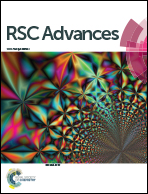Graphitized activated carbon based on big bluestem as an electrode for supercapacitors†
Abstract
Activated carbon based on biochar is an attractive material for energy storage in terms of its high specific capacitance and low cost. The activated carbon samples were based on big bluestem biochar, which is the waste from a thermochemical process optimized for bio-oil production. Sodium bicarbonate, sodium hydroxide and potassium hydroxide were used as reagents to obtain the activated carbon samples. The surface area and pore structure of the activated carbon, characterized by the N2 adsorption–desorption method, were firmly in conjunction with those of the reagents. The high specific surface area (2490 m2 g−1) of the activated carbon was achieved by the activation of potassium hydroxide. Scanning electron microscopy and Raman spectroscopy were used to test the microstructure and crystallographic orientation of the carbon samples. Concerning the G band (1580 cm−1) and the ratio of this with the D band (1338 cm−1), which was 0.55, the Raman spectrum indicated that the potassium hydroxide activated carbon sample contained sp2 carbon. The 2D (2680 cm−1) band showed that this activated carbon has similar properties to multilayer graphene. The cyclic voltammetry, galvanostatic charge–discharge and electrochemical impedance spectroscopy were measured after the activated carbon was assembled into supercapacitors. The potassium hydroxide activated carbon sample presented a high specific capacitance of 283 F g−1, and a relatively low inner resistance of 2 ohm.


 Please wait while we load your content...
Please wait while we load your content...